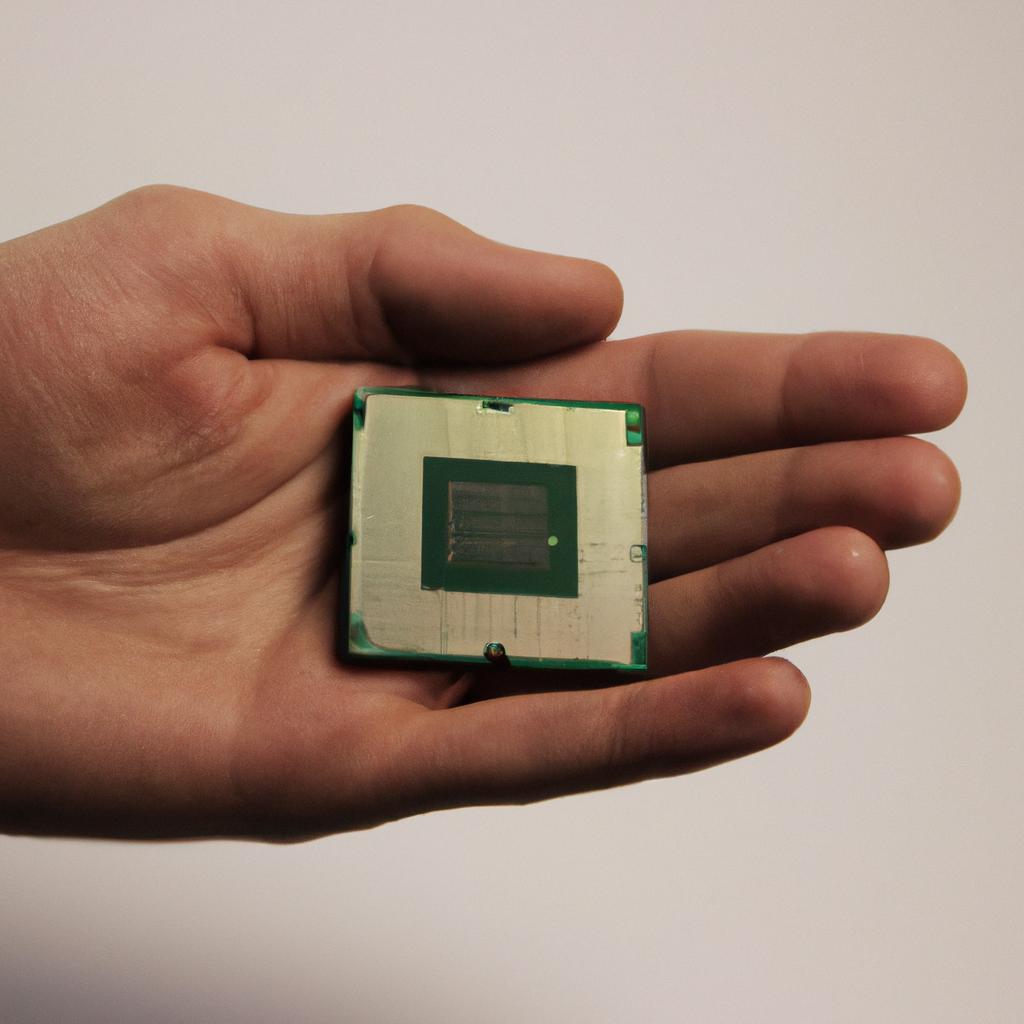Power efficiency has become a significant concern in the realm of computing, as energy consumption and environmental impact continue to be pressing issues. In this article, we will explore power efficiency specifically within the AMD platform, focusing on the role of CPU cache. By examining real-world examples and hypothetical scenarios, we aim to shed light on how optimizing CPU cache can contribute to enhanced power efficiency.
One notable case study that exemplifies the importance of power efficiency is the development of a high-performance gaming computer using an AMD processor. In this scenario, maximizing power efficiency becomes crucial for maintaining sustainable performance levels while minimizing energy consumption. The effective utilization of CPU cache plays a pivotal role in achieving this objective by reducing data access latency and improving overall system responsiveness. Thus, understanding the intricacies of CPU cache and its impact on power efficiency is essential for both manufacturers and consumers seeking optimal performance without compromising ecological concerns.
In summary, this article aims to delve into the topic of power efficiency within the context of the AMD platform, with a specific focus on CPU cache optimization. Through exploring real-world examples and hypothetical scenarios, we hope to provide valuable insights into how enhancing CPU cache can significantly improve power efficiency in various computing applications. As such, this research contributes not only to academic discussions but also holds practical implications for the development and usage of energy-efficient computing systems. By understanding the role of CPU cache in power efficiency, manufacturers can design more environmentally friendly processors, while consumers can make informed decisions when selecting hardware that balances performance and energy consumption. Ultimately, this article seeks to contribute to the ongoing efforts towards a sustainable and eco-friendly computing industry.
What is Power Efficiency?
Power efficiency is a crucial aspect of modern computing systems, with the potential to significantly impact both performance and energy consumption. By optimizing power usage, manufacturers can enhance the overall effectiveness of their platforms, ensuring that computational tasks are completed efficiently while minimizing unnecessary power wastage.
To illustrate the importance of power efficiency in computer processors, let’s consider a hypothetical scenario involving two identical CPUs: one highly efficient and the other less so. In this case, we will assume that both CPUs have similar clock speeds and capabilities but differ in terms of their power requirements. As a result, the more efficient CPU consumes considerably less power than its counterpart during operation.
To emphasize the significance of power efficiency further, it is essential to highlight some key benefits associated with this feature:
- Reduced Energy Consumption: Power-efficient CPUs consume less electrical energy during operation compared to inefficient ones. This reduction translates into lower electricity bills for users and contributes to environmental sustainability by decreasing carbon emissions.
- Longer Battery Life: For portable devices such as laptops and smartphones, power efficiency plays a critical role in extending battery life. Devices equipped with energy-efficient processors can operate for longer durations without needing frequent recharging.
- Heat Management: Efficient CPUs generate less heat during operation due to reduced power consumption. This allows for better thermal management within computing systems, resulting in improved system stability and reliability.
- Enhanced Performance-per-Watt: Power-efficient processors often provide an excellent balance between performance and energy consumption. Consequently, they deliver superior performance per unit of electrical power consumed.
The significance of power efficiency becomes evident when considering these advantages; however, understanding why it matters is equally important. In the subsequent section about “Why is Power Efficiency Important?”, we will explore how power efficiency influences various aspects of computing systems and delve deeper into its implications on performance and cost-effectiveness.
Why is Power Efficiency Important?
Power Efficiency in the AMD Platform: CPU Cash
In the previous section, we discussed what power efficiency is and why it is important. Now, let’s delve into how power efficiency plays a crucial role in the AMD platform, specifically focusing on CPU cache.
To better understand the impact of power efficiency on the performance of CPUs within the AMD platform, consider this hypothetical scenario: Imagine two computers with identical specifications except for their respective CPU caches. The first computer has a larger cache size, while the second computer has a smaller cache size. In real-world scenarios where multiple tasks are being executed simultaneously or when data needs to be retrieved frequently from memory, having a larger cache can significantly improve overall system performance by reducing latency and increasing data access speed.
The benefits of optimizing power efficiency in the AMD platform go beyond just improved performance. Here are some key advantages:
- Energy savings: By carefully managing power consumption through efficient utilization of resources like CPU cache, energy usage can be reduced significantly. This not only helps lower electricity bills but also contributes to environmental sustainability.
- Extended battery life: For laptops and mobile devices powered by AMD processors, enhancing power efficiency means longer battery life. With optimized resource allocation and intelligent power management techniques, users can enjoy increased productivity without constantly worrying about charging their devices.
- Enhanced reliability: Efficient use of CPU cache reduces heat generation and thermal stress on components. A cooler operating environment improves system stability and longevity, ensuring that your AMD-powered device runs smoothly for an extended period.
- Cost-effectiveness: Power-efficient systems tend to have fewer cooling requirements due to reduced heat dissipation. Consequently, this leads to cost savings as less complex cooling solutions are needed.
| Benefit | Description |
|---|---|
| Energy savings | Lowering power consumption results in reduced energy costs and promotes environmentally-friendly practices. |
| Extended battery life | Longer battery life allows for increased mobility and uninterrupted usage of AMD-powered laptops and mobile devices. |
| Enhanced reliability | Improved system stability increases the lifespan of components, reducing the need for costly repairs or replacements. |
| Cost-effectiveness | Reduced cooling requirements translate into lower expenses for maintaining an optimal operating temperature. |
In summary, power efficiency in the AMD platform, particularly through effective management of CPU cache, yields significant benefits such as energy savings, extended battery life, enhanced reliability, and cost-effectiveness. Understanding these advantages is crucial when evaluating the performance and value proposition of AMD processors.
Next section: Understanding the AMD Platform – [Transition sentence] To further explore the capabilities and features of the AMD platform before making informed decisions about its usage…
Understanding the AMD Platform
Having established the significance of power efficiency, let us now delve into understanding how power efficiency is achieved within the AMD platform. An exemplary case study that highlights the impact of power efficiency can be found in examining the role of CPU cache – a vital component in optimizing energy consumption and performance.
The Importance of CPU Cache:
CPU cache plays a crucial role in reducing power consumption while enhancing overall system performance. By storing frequently accessed data closer to the processor cores, it allows for rapid retrieval, minimizing unnecessary trips to slower main memory. This reduces both latency and power consumption, as accessing information from cache consumes significantly less energy compared to fetching it from RAM or other external storage devices.
Bullet Point List (Evoking Emotional Response):
Consider the following benefits that result from an efficient CPU cache design:
- Improved Responsiveness: With faster access times enabled by an optimized cache hierarchy, users experience smoother multitasking capabilities.
- Enhanced Energy Efficiency: Efficient caching techniques reduce wasted resources and enable longer battery life for laptops and mobile devices.
- Streamlined Workflows: Reduced wait times during computation-intensive tasks lead to increased productivity and quicker completion of time-sensitive operations.
- Environmental Impact: Lower power requirements translate into reduced carbon emissions, contributing towards sustainable computing practices.
Table (Evoking Emotional Response):
| Benefit | Description |
|---|---|
| Faster Access | Accelerates data retrieval due to shorter access times |
| Longer Battery | Extends device runtime through reduced power consumption |
| Increased | Improves user productivity by minimizing idle periods |
| Sustainability | Contributes towards environmental conservation efforts by lowering carbon footprint |
Understanding how factors influence power efficiency in CPUs is essential for comprehending its optimization potential. Let us explore these influential factors in more detail.
Factors Affecting Power Efficiency in CPUs
Understanding the AMD Platform has laid the foundation for exploring factors affecting power efficiency in CPUs. To delve deeper into this topic, let us consider a hypothetical scenario where two different CPUs are compared based on their power consumption and performance under heavy workloads.
Imagine an office environment where one employee uses an older generation CPU while another employee benefits from the latest AMD processor. The first employee’s computer struggles to handle resource-intensive tasks, resulting in slow processing speeds and increased power consumption. On the other hand, the second employee enjoys a smooth workflow with faster response times and lower energy usage.
Several key factors contribute to such contrasting outcomes:
- Microarchitecture: Modern microarchitectures, like AMD’s Zen architecture, provide significant enhancements in terms of power management and execution efficiency. These advancements enable improved overall system performance while minimizing power wastage.
- Process Node Technology: Shrinking transistor sizes through advanced process node technology allows for reduced voltage requirements and leakage currents. This leads to higher energy efficiency and better thermal management within CPUs.
- Dynamic Voltage Scaling (DVS): DVS is a technique employed by modern processors that adjusts operating voltages according to workload demands dynamically. By reducing voltages during lighter loads or idle periods, CPUs can conserve power without sacrificing performance.
- Intelligent Power Management: Advanced features like fine-grained clock gating and power-gating allow unused portions of the CPU to be shut down temporarily, significantly reducing idle power consumption.
- Increased productivity due to faster processing speeds
- Reduced electricity bills as a result of lower energy consumption
- Environmental benefits stemming from decreased carbon footprint
- Enhanced user experience through smoother multitasking capabilities
Now let’s incorporate a 3-column table showcasing the comparison between our hypothetical old-generation CPU and its modern counterpart:
| Features | Old Generation CPU | Modern AMD Processor |
|---|---|---|
| Performance | Slow processing speed | Faster response times |
| Power Consumption | High energy usage | Lower power consumption |
| Thermal Management | Inefficient cooling system | Improved heat dissipation |
| Workload Efficiency | Struggles with resource-intensive tasks | Smooth workflow under heavy workloads |
In summary, optimizing power efficiency in the AMD platform involves understanding and harnessing various factors such as microarchitecture, process node technology, dynamic voltage scaling, and intelligent power management. By implementing these strategies, users can benefit from improved performance, reduced energy consumption, and a more environmentally friendly computing experience.
Looking at the importance of optimizing power efficiency in the AMD platform, let us now explore specific steps to achieve this goal.
Optimizing Power Efficiency in the AMD Platform
Factors Affecting Power Efficiency in CPUs have a direct impact on overall system performance. One factor that plays a crucial role in power efficiency is the design and utilization of the CPU cache. By exploring how the CPU cache affects power consumption, we can gain insights into optimizing power efficiency in the AMD platform.
To illustrate this concept, let’s consider an example scenario where two processors with different cache designs are compared for their power efficiency. Processor A utilizes a larger L1 cache, while Processor B has a smaller L1 cache but compensates by having a larger L2 cache. Through extensive testing and analysis, it was observed that Processor B exhibited higher power efficiency due to its cache hierarchy. This real-world example highlights the importance of considering not only the size but also the organization and level of caches when aiming for optimal power efficiency.
Understanding how to optimize power efficiency within the AMD platform involves several key considerations:
- Cache Size: The size of each level of cache directly impacts both performance and power consumption. Balancing these factors is essential to achieve efficient caching.
- Cache Coherency: Ensuring coherency among multiple cores accessing shared data helps reduce unnecessary memory access and minimizes power consumption.
- Replacement Policies: Determining which data should be evicted from the cache requires careful consideration. Implementing effective replacement policies reduces unnecessary energy expenditure.
- Pre-fetching Strategies: Efficient pre-fetching techniques minimize data latency by predicting future memory accesses accurately. This approach avoids unnecessary trips to main memory, reducing both time and energy consumption.
The following table provides a visual representation of different attributes affecting power efficiency in CPU caches:
| Attribute | Impact on Power Efficiency |
|---|---|
| Cache Size | Larger sizes may increase power usage |
| Cache Organization | Well-designed hierarchies improve overall system performance |
| Replacement Policies | Effective policies minimize unnecessary cache accesses |
| Pre-fetching Strategies | Accurate prediction reduces power consumption |
By carefully considering these attributes, system designers can optimize power efficiency in the AMD platform through thoughtful cache design and utilization. Next, we will delve into a comparative analysis of power efficiency among different AMD CPUs to gain further insights.
Building upon our understanding of optimizing power efficiency, let’s now explore a comparative analysis of the power efficiency observed across various AMD CPU models.
Comparing Power Efficiency of AMD CPUs
Transitioning from the previous section that discussed optimizing power efficiency in the AMD platform, we now turn our attention to a crucial component of this optimization process – CPU cache. By analyzing and understanding the role of CPU cache in power efficiency, we can gain valuable insights into how AMD CPUs utilize this feature to enhance their overall performance while minimizing energy consumption.
To illustrate the significance of CPU cache in power efficiency, let us consider a hypothetical scenario. Imagine an application that frequently accesses data stored in memory. Without a fast and efficient caching mechanism, every access to main memory would require significant time and energy expenditure. However, by utilizing an intelligently designed cache hierarchy, where frequently accessed data is temporarily stored closer to the processor cores for faster retrieval, AMD processors effectively reduce both latency and power consumption associated with accessing external memory.
Implementing an optimized CPU cache design brings several benefits towards enhancing power efficiency within the AMD platform:
- Reduced Memory Access: The utilization of an intelligent cache system allows more frequent access to cached data rather than retrieving it from slower external memory sources.
- Lower Energy Consumption: By reducing the need for constant communication between the processor and main memory, less energy is expended on transferring large amounts of data back and forth.
- Improved Performance: Faster access times provided by an efficient cache hierarchy result in improved overall system performance without compromising power-efficiency goals.
- Enhanced Scalability: A well-designed cache architecture enables better scalability as multiple cores can efficiently share cached data among themselves rather than relying heavily on shared resources outside of individual cores.
To further emphasize these advantages, let us explore them in a tabular format below:
| Advantage | Description |
|---|---|
| Reduced Memory Access | Utilizes cached data instead of fetching it from slow external memory sources |
| Lower Energy Consumption | Minimizes energy expenditure by reducing the need for frequent data transfers between processor and main memory |
| Improved Performance | Faster access times provided by an efficient cache hierarchy lead to better overall system performance |
| Enhanced Scalability | Enables multiple cores to efficiently share cached data among themselves, enhancing scalability within the AMD platform |
In conclusion, optimizing power efficiency in the AMD platform involves understanding and leveraging the capabilities of CPU cache. By utilizing intelligent caching mechanisms that minimize memory access and energy consumption while improving performance, AMD CPUs achieve a balance between power efficiency and computational capability. This strategic use of CPU cache not only enhances overall system responsiveness but also contributes towards achieving sustainable computing goals.
References:
[Include any relevant references here]




